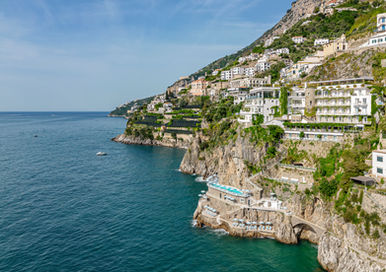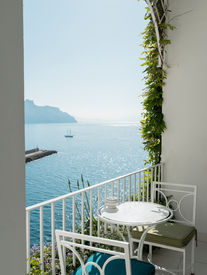
August 22, 2025 | TRAVEL
a DREAMY LONG WEEKEND in AMALFI
words Onur Basturk
photos Courtesy of Hotel Miramalfi
The 1960s… First came Fellini’s La Dolce Vita. Then the glamorous wave of Hollywood stars and European aristocracy descending on the Amalfi Coast. And soon after, a spontaneous style revolution: handmade leather sandals, linen dresses, Vietri ceramics. That iconic lifestyle of the ’60s still lingers on the Amalfi shores today. But to truly experience its allure, you need to know where to go. Consider this your compass.

DAY ONE: MY HOTEL, MIRAMALFI
From Naples Airport, the transfer wound its way through the dramatic Lattari Mountains framing the Sorrento Peninsula before descending towards the Amalfi Coast. Passing Ravello, the road down revealed staggering views—mesmerizing in every sense.
By the time I arrived at Hotel Miramalfi, just five minutes from Amalfi’s center, my mind was still caught on those mountain vistas. The receptionist seemed to read my thoughts: “Would you like a cold prosecco?” Of course—who could ever refuse? I carried it straight to the balcony at Mario’s Lounge Bar, and there it was: the Amalfi view I had been dreaming of.
Perched dramatically on the cliffs, Miramalfi is a design hotel with roots stretching back to 1956. Founded by Francesco Mansi after returning from years in Mexico, the hotel is still run by the Mansi family today. Miramalfi helped define the golden age of the 1960s, introducing modernist architecture to the Mediterranean and contributing to the emergence of beach club culture.
A major renovation in 2022 gave Miramalfi a fresh identity while preserving its ’60s spirit. I felt it immediately upon entering my room: soft lines balanced with bold colors, and from the balcony, the endless sweep of the Mediterranean. The balcony alone could hold me captive for hours, yet Amalfi’s call was impossible to resist.
My first stop was the hotel’s iconic beach club. With its saltwater pool and cheerful blue-and-white umbrellas, it radiated pure positivity. I swam, stretched out on a lounger, and drifted into a seaside nap—slipping into a dream with Amalfi as both the setting and the backdrop.
That evening, I wandered into town—just 800 meters away—for dinner at Donna Stella Pizzeria, run by sisters Germana and Lorenza, affectionately known as the “Pizza Sisters.” The recommendation held true: the pizza was unforgettable.

DAY TWO: EATING & DRINKING IN POSITANO
The next morning began with an espresso on my balcony before walking down to Amalfi’s harbor to catch the ferry to Positano. Visiting in high season is pure madness—the crowds can be overwhelming. But it’s easy to escape them. Around 1 p.m., I slipped away to the now-iconic Da Adolfo for lunch, then returned to Positano afterward.
Getting there is half the charm: look for the small boat marked with a red fish, reserved for those lucky enough to have a booking. Just one catch—reservations are famously elusive. No phone, no email. The best strategy? Show up and hope for the best.
Back in Positano, sunset calls for a drink. Normally the place to be is Franco’s, but on this trip it was temporarily closed. The Champagne Bar at Le Sirenuse made for a worthy alternative. Other favorites include Tridente Cocktail Bar at Hotel Poseidon, La Giara Rooftop Bar, or the leafy, refined garden bar at Palazzo Murat (no sunset views here, but plenty of charm).
For dinner, Chez Black remains the legendary go-to—reliable and ever-buzzing. Next2 offers a modern, design-forward take while keeping the atmosphere relaxed. Lo Guarracino is beloved for its seafood pasta by the sea, while Ristorante Da Gabrisa wins with panoramic views. La Tagliata is pure Italian family spirit—everyone on staff is related—and Casa Mele delivers an elegant, fine-dining feel.
DAY THREE: STAYING PUT
My third day was devoted entirely to Miramalfi. As the sun dipped, I headed to the hotel’s signature restaurant, Donna Emma—named after the founder’s wife, celebrated for her love of traditional Italian cooking. The menu reflects her spirit: handmade pasta, fresh seafood, seasonal vegetables—simple, soulful, and served on a terrace that seems to float above the sea.
On my final morning, I sat once more on my balcony with a glass of prosecco, watching the light shift over the Amalfi horizon. And I made myself a quiet promise: Amalfi isn’t a once-in-a-lifetime place—it’s a place you return to.
























